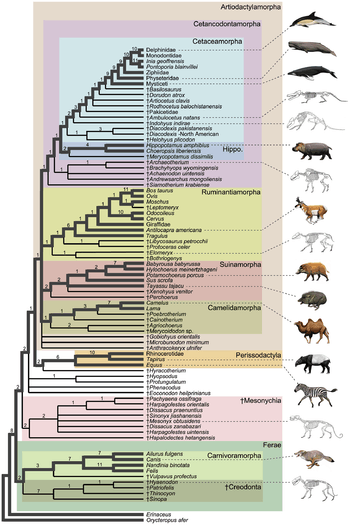Suina
| Suina Temporal range: Late Eocene to Holocene, 33.9–0 Ma | |
|---|---|
 | |
| Potamochoerus porcus | |
| Scientific classification | |
| Kingdom: | Animalia |
| Phylum: | Chordata |
| Clade: | Synapsida |
| Class: | Mammalia |
| Order: | Artiodactyla |
| Clade: | Artiofabula |
| Suborder: | Suina Gray, 1868 |
| Families | |
The suborder Suina (also known as Suiformes) is a lineage of omnivorous non-ruminant artiodactyl mammals that includes the pigs and peccaries of the families Suidae and Tayassuidae and their fossil kin. Hippopotamidae had historically been classified among the Suina for morphological reasons, but is now more often classified as the sister group of the whales, or Cetacea.
Classification

The suborder Suina includes Suidae (pig family) and Tayassuidae (peccary family).
The Merycoidodonts, or "oreodonts", a branch of the tylopoda, were often considered suines due to the popular, though inaccurate, description of them as "ruminating hogs". Oreodonts were not suines, they were more closely related to camels. Similarly, the entelodonts had long been classified as members of Suina. Spaulding et al. have found them to be closer to whales, than to pigs in her Cetacodontamorpha.[1]
Some morphological studies have suggested that the hippopotamus family Hippopotamidae was part of the Suina, but a growing body of morphological and genetic evidence has suggested that they share a common ancestor not with the Suina, but with Cetaceans—the clade that includes whales and dolphins. Whales and artiodactyls form a clade called Whippomorpha.[2]
| Artiodactyla |
| ||||||||||||||||||||||||
| |
The most recent research into the origins of hippopotamidae suggests that hippos and whales shared a common semi-aquatic ancestor that branched off from other Artiodactyls around 60 million years ago.[3] Descendants of this hypothesized ancestor likely split into two branches around 54 million years ago.[4] One branch would evolve into cetaceans, possibly beginning with the proto-whale Pakicetus from 52 million years ago and other early whale ancestors, known as Archaeoceti, which eventually underwent aquatic adaptation into the almost completely aquatic cetaceans.[2]
Anatomy
The anatomy of the Suina differs from other even-toed ungulates. For example, they have maxillary (upper) teeth in front, which allows for the proper chewing of food. In contrast, other even-toed ungulates, such as goats and deer, have front teeth only on the bottom; this does not let them chew very well, thus they swallow and regurgitate their food to allow rumination.
Most even-toed ungulates have a four-chambered stomach. In contrast, the Suina have a simple stomach that allows an omnivorous diet.

Most members of Suina have toes rather than hooves. While most artiodactyls have long slender legs, the Suina generally have short, stubby legs.
See also
References
- ↑ Spaulding, M; O'Leary, MA; Gatesy, J (2009). Farke, Andrew Allen, ed. "Relationships of Cetacea (Artiodactyla) Among Mammals: Increased Taxon Sampling Alters Interpretations of Key Fossils and Character Evolution". PLoS ONE. 4 (9): e7062. doi:10.1371/journal.pone.0007062. PMC 2740860
 . PMID 19774069.
. PMID 19774069. - 1 2 Boisserie, Jean-Renaud; Fabrice Lihoreau; Michel Brunet (February 2005). "The position of Hippopotamidae within Cetartiodactyla". Proceedings of the National Academy of Sciences. 102 (5): 1537–1541. doi:10.1073/pnas.0409518102. PMC 547867
 . PMID 15677331. Retrieved 2007-06-09.
. PMID 15677331. Retrieved 2007-06-09. - ↑ Gatesy, J. (1 May 1997). "More DNA support for a Cetacea/Hippopotamidae clade: the blood-clotting protein gene gamma-fibrinogen". Molecular Biology and Evolution. 14 (5): 537–543. doi:10.1093/oxfordjournals.molbev.a025790. PMID 9159931.
- ↑ Ursing,B.M.; U. Arnason (1998). "Analyses of mitochondrial genomes strongly support a hippopotamus-whale clade". Proceedings of the Royal Society. 265 (1412): 2251–5. doi:10.1098/rspb.1998.0567. PMC 1689531
 . PMID 9881471.
. PMID 9881471.
External links
- http://www.paleocene-mammals.de/condylarths.htm
- http://www.ultimateungulate.com/Cetartiodactyla.html